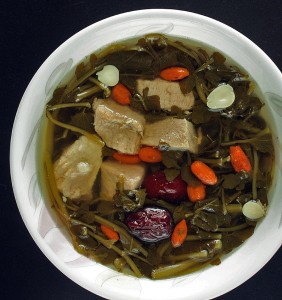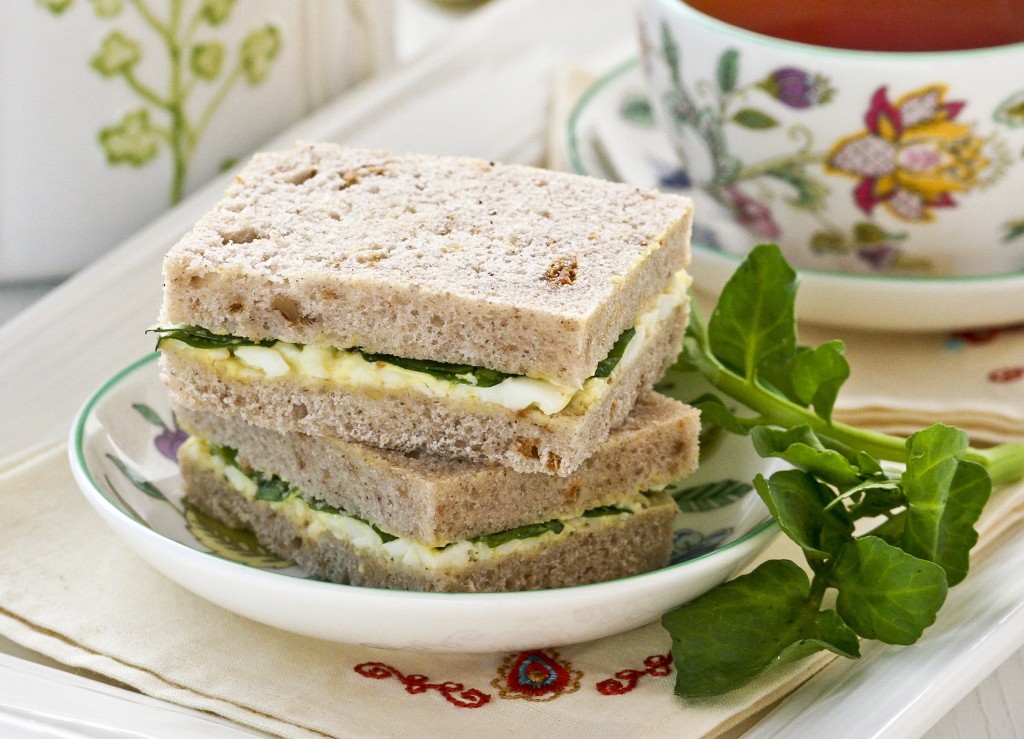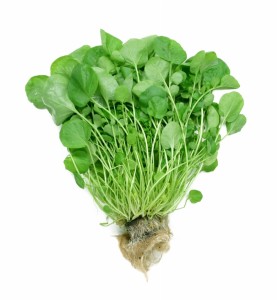Nasturtium officianale
Native Range: Northern Africa, Europe, temperate Asia, and India
Invasive Range: In USA: all lower 48 states, except North Dakota. Found in Alaska, Puerto Rico, and the Virgin Islands. Also southern Canada, Sub-Saharan Africa, South America, Australasia, and parts of tropical Asia.
Habitat: Common along stream margins, ditches, and other areas with cold flowing water.
Description: Watercress forms a carpet of small round leaves. White flowers appear above the water from March through October. Like other members of the mustard family (Brassicaceae), watercress has a pungent, peppery taste.
Native to Eurasia, watercress has likely been gathered as food since food-gathering began. It was introduced to the Western Hemisphere by European settlers, who may have used it as an antiscorbutic, to counteract scurvy
How far back did cultivation really start? No one knows for sure. Germany in the sixteenth century is the usual starting point. The United Kingdom and the United States didn’t take up the practice until the early nineteenth. Now most parts of the world with clear, clean, running water raise it—so it has invaded almost everywhere.
1847
Officinal Nasturtium. Vulgò—Water Cress.
Fr. Cresson de Fontaine. Germ. Die Brunnenkresse. Span. Bérro.
Observation. This plant (well known as the “Water Cress,” in England,) was detected in Chester County, Penn. by my friend Mr. Joshua Hoopes, since the publication of the Flora Cestrica [1838]. Although abundant in some rivulets, there is reason to believe it is not a native. It affords an excellent wholesome Salad––antiscorbutic in its properties, as all the Cruciferae are; and being easily propagated, is worthy of being introduced into all suitable localities.
—William Darlington, Agricultural Botany: an Enumeration and Description of Useful Plants and Weeds which Merit the Notice, or Require the Attention, of American Agriculturists
1920
Water-cress, known to everybody (Nasturtium officinale, R. Br.) and originally introduced, at least in the East, from Europe, is now a common aquatic throughout a large part of the United States and Canada. The waters of springs and brooks are often found thickly blanketed with green coverlets of this plant dotted with the tiny white flowers, and lending spice to the wayfarer’s luncheon.
—Charles Francis Saunders, Edible and Useful Wild Plants of the United States and Canada
1943
In gathering Water-Cress great care should be taken not to confuse other plants with it, since the deadly Water-Hemlocks grow in habitats where the cress is often found. Beware also of contaminated water, too near farms or towns, or, in the woods, flowing by remote piggeries. In using Water-Cress it is safest always to disinfect it by using some harmless, disinfecting wash. . . . One can’t be sure of the water in which it grew.
—Lyndon Fernald and Alfred Charles Kinsey, Edible Wild Plants of Eastern North America
1962
Being originally a cultivated plant that ultimately began growing wild, water cress is seldom found far from the haunts of men. If there is none growing in the stream handiest to you, this situation is easily corrected. A handful of stems pulled from any bed of water cress and tossed into the stream at a favorable spot will rapidly take root and spread. If you don’t know where you can get water cress to transplant, several of the seed houses handle water cress seed.
—Euell Gibbons, Stalking the Wild Asparagus
Rereading Gibbons, the Armchair Forager was shocked to come to this passage. Fifty years ago, we thought he was just suggesting some lazy gardening. Now we know better. Never move invasive species from one place to another—unless you’re planning to consume them. Make sure that all possible propagules and seeds do not get into the environment, whether through the yard or the compost been. Dispose of carefully. Don’t spread!
*Egg and watercress image courtesy of Linda Ooi
Harvest
Watercress grows along stream and river edges in low-growing carpets. Leaves taste bright, fresh, and peppery.
Green Deane harvests watercress in Florida.
Follow Richard Lamb of New York’s Foragers City Grocer, as he harvests watercress in Upstate New York here.
Note: Plants should be washed carefully prior to consumption to avoid accidental ingestion of microscopic parasites, such as the protozoan Giardia, that may be present in untreated water.
Recipes
How the French Eat Wild Watercress
1. Cooked with butter (étuve au beurre—everything sounds better in French).
2. Cooked with cream (étuve à la crème).
3. Cooked au jus.
4. As garnish (garniture de cresson).
5. As purée.
6. As salad, dressed with oil & vinegar or lemon juice.
7. In a sandwich, finely chopped leaves go well with mayonnaise.
8. Cream of watercress soup––the famous potage cressonière.
How Euell Gibbons Ate Wild Watercress
1. In a salad, just as John Evelyn recommended in his Discourse of Sallets, published in London in the seventeenth century. Copies were likely carried to North America by settlers, along with seeds.
Gibbons claims cress improves any salad.
2. Cooked like spinach, with or without other greens. (Cooking can also kill giardia and other parasites.)
3. Cream of watercress soup, a classic from across the Pond. See the recipe, based on The Paris Cookbook by Patricia Wells, here.
4. As an addition to egg-salad sandwich filling.
5. “To make some snooty little sandwiches for an afternoon tea.”
1 cup of chopped water cress
1/4 cup of chopped nuts (hickory, pecan, or walnut)
some mayo and a little salt
6. In herb butter, “for which you will find 1,000 uses.”
Cream 1/4 pound butter at room temperature
Blend in gradually 1 tablespoon each of finely chopped watercress, parsley, chives and a 1/4 teaspoon salt. Place in fridge to harden.

How the Chinese Eat Watercress
In the United States, the biggest market for watercress is from Chinese communities, where it is known as 西洋菜 (xi yang cai). Watercress with beef or pork, is especially popular as is watercress soup. Follow the link to a mouthwatering recipe here
Japanese Noodle Soup with Clams and Watercress
Watercress is also popular in Japan. This recipe would be ideal with invasive Manilla clams on the West Coast of North America
Marmite and Watercress Sandwiches
We wouldn’t want you to miss this treasure of a British teatime special.
Marmite is a spreadable brewers’ yeast extract. The secret to using it is to mix a very small quantity with a large quantity of soft butter. (Cream cheese would also work well.)
Ingredients
Marmite
1 stick of butter, softened
Fresh watercress
Mix Marmite and butter together. Start with just a dab of Marmite, adding more—sparingly—to taste.
Spread Marmite mixture on fresh-baked crusty white bread.
Pile on crisp watercress.
Top with another slice of bread.
Cut into four small sandwiches.





























{ 1 comment… read it below or add one }
A friend informed me about the possibility of contracting the parasite Fasciola hepatica (liver fluke) if one consumes parts of watercress plants that have been under water at some point. Apparently cooking watercress before eating it can kill this helminth. https://rarediseases.org/rare-diseases/fascioliasis/
Also, I live in California. Interestingly, Calflora lists Nasturtium officinale as a native plant here.